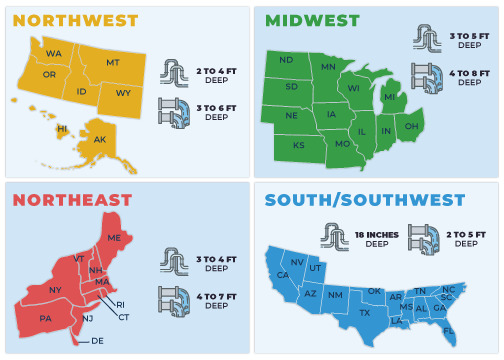- AppliancesElectriciansHVACLandscapingLocksmithPest ControlPlumbingRenovationRoofingT V RepairAll Home Improvement
- Car AccidentClass ActionCorporate LawCriminal DefenseDivorce LawEmployment LawFamily LawFinancial LawLegal AidMedical Injury LawyersMedical MalpracticeReal Estate LawWater Fire RestorationAll Legal
- InvestmentRetirementAll Finance
- Animal InsuranceAutoGeneral InsuranceHealth PolicyHome RentersAll Insurance
- DentalHealth SpecialistsAll Medical
- Animal CareVeterinaryAll Pets
- Auto GlassTowingAll Automotive
How Deep Are My Water and Sewer Lines Buried?

The intricate network of pipes beneath our homes silently delivers fresh water and whisks away wastewater. But have you ever wondered how deep these water lines are buried? It can be useful information for various reasons, including planning landscaping projects and troubleshooting potential issues.
Nationally, residential water lines are typically buried between 18 inches and 5 feet underground. However, this depth range is more of a suggestion than a hard-and-fast rule. Several factors influence the exact depth at which your water line resides.
- Frost depth: This is the average depth at which the ground freezes in the winter. Colder climates with deeper frost lines require burying water lines deeper to prevent them from freezing and potentially bursting.
- Local codes: The regulations established by your state or local county often dictate the minimum depth for burying water lines. In addition to frost depth, these codes consider factors such as soil conditions and potential traffic over the buried lines. Consult your local building department to discover the specific depth code for your area.
- Soil conditions: The type of soil in your area can also play a role. For instance, rocky or heavily compacted soil might necessitate burying water lines deeper to ensure they're adequately protected.
How Deep Are Residential Septic or Sewer Lines Buried, on Average?
As with water lines, the depth of residential sewer lines varies depending on location and code requirements. Generally, sewer lines are buried deeper than water lines, with a typical depth range of 2 to 8 feet. Here's the reasoning:
- Preventing damage: Sewer lines transport wastewater, which can be quite hot depending on its source. Burying them deeper helps maintain cooler soil temperatures around the pipes, preventing damage from heat expansion.
- Avoiding contamination: Sewer lines carry contaminated water, so a deeper placement helps minimize the risk of contaminating groundwater or surface water in case of a leak.
Local building codes often dictate the minimum depth for burying sewer lines. The specific depth can also be determined by factors such as above-ground structures and landscaping features.
More Related Articles:
- Calling a Plumber? Here Are the 6 Most Common Plumbing Jobs and How Much They Cost
- 6 Ways to Try to Unclog Your Sink Before You Call a Plumber
- What's in My Plumber's Van?
- Here's How Much It Costs to Remodel a Bathroom
- 6 Tips for Hiring a Plumber
Here's a brief look at average water and sewer line depth ranges nationwide.
- Midwest: A colder climate and deeper frost lines mean water lines in these states can be buried anywhere from 3 to 5 feet deep. Sewer lines typically have depths ranging from 4 to 8 feet.
- Northeast: The Northeast also experiences cold winters with significant frost penetration. Water lines here are generally buried between 3 and 4 feet, while sewer line depths range from 4 to 7 feet.
- Northwest: The Pacific Northwest experiences a variety of climates, with coastal regions being more temperate and inland areas experiencing colder winters. Water line depths here can vary from 2 to 4 feet, with sewer lines ranging from 3 to 6 feet deep.
- South: Warmer climates in the South often mean shallower burial depths. Water lines here might be buried as shallow as 18 inches, while sewer lines typically range from 2 to 5 feet deep.
- Southwest: The Southwest generally enjoys a warm climate too. Water lines here can be buried as shallow as 18 inches, while sewer lines typically range from 2 to 4 feet deep.
Important note: These depth ranges are for informational purposes only and should not be taken as a substitute for consulting your local building department or a qualified plumber.
Elocal Editorial Content is for educational and entertainment purposes only. Editorial Content should not be used as a substitute for advice from a licensed professional in your state reviewing your issue. Systems, equipment, issues and circumstances vary. Follow the manufacturer's safety precautions. The opinions, beliefs and viewpoints expressed by the eLocal Editorial Team and other third-party content providers do not necessarily reflect the opinions, beliefs and viewpoints of eLocal or its affiliate companies. Use of the Blog is subject to the
Website Terms and Conditions.The eLocal Editorial Team operates independently of eLocal USA's marketing and sales decisions.



